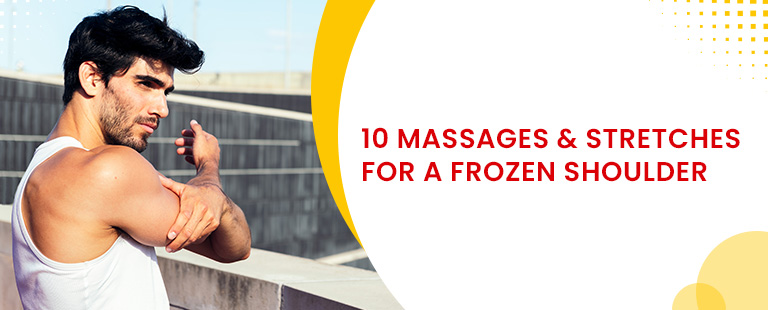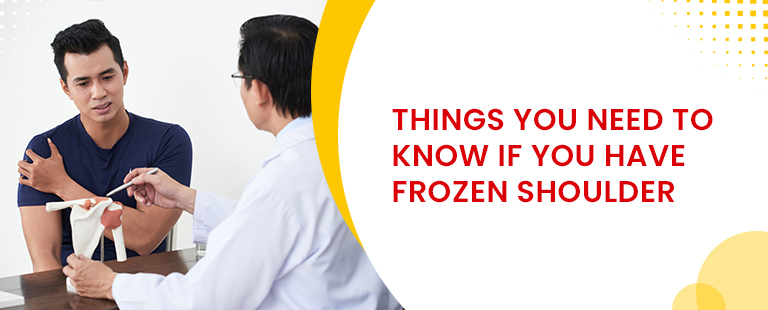Frozen shoulder massage treatment is required in case your shoulder has lost mobility to the extent it feels like it is frozen in place. The loss of mobility makes it difficult to continue with daily activities and causes pain during movements.
For frozen shoulder massage treatment, you should begin with complete massage therapy for frozen shoulder. Consult a doctor and a physiotherapist for proper guidance and recovery.
Frozen shoulder is caused due to triggering of myofascial points in the shoulder muscles and surrounding areas. These trigger points are muscle knots or lumps in sensitive regions due to injury, accident, or pain due to another chronic condition. Capsular stretching for frozen shoulders reduces pain and improves motion and muscle strength. These frozen shoulder massage techniques would also work on the trigger points and subsequently improve blood circulation, reduce spasms, and relieve symptoms.
There are specific trigger points which affect the frozen shoulder. Gaining knowledge about these points and their locations in the arms and shoulders helps to understand how to use capsular stretching for frozen shoulders.
Massages for frozen shoulder
Before starting any Shoulder stretches for frozen shoulder on your own, consult your doctor. The physical therapist would guide you through the postures and stretches. They will ensure that the frozen shoulder massage is done correctly, as incorrect massages can worsen the situation.
It is better to have a professional therapist to guide you. You can begin with a self massage for frozen shoulder and follow these messages.
Foam roller underarm massage:
You can start with this stretching exercise for frozen shoulder by following these steps:
Place a foam roller under the underarm of the affected shoulder
- rest your arm on the floor
- Lengthen your arm
- Slowly roll back and forth over the roller
- Continue for a minute
Foam roller shoulder massage:
- Place a foam roller under the underarm of the affected shoulder
- Lengthen your arm with the hand extended upwards
- Move over the roller a few times
Simple self-massage:
- Use your other hand for massage therapy for frozen shoulders.
- Focus on the sensitive regions
- Try to move about the affected shoulder while massaging the shoulder and arm simultaneously
Stretches for frozen shoulder
Warm up your shoulder muscles before beginning with shoulder stretches for frozen shoulders. You can do it by taking a warm shower or a bath. You can also use a heating pad.
Gently start with capsular stretching for frozen shoulders to an extent where you are comfortable. Do not force any movement and gradually progress by repeating the movement multiple times in a day.
You can start with some of these best stretches for frozen shoulder for your recovery.
Pendulum swing:
- Stand straight and keep your unaffected hand on the edge of a table
- Lean forward while maintaining balance
- Start by swinging your arm back and forth in a circular motion in both directions
- Repeat at least ten times
Cross-body stretch:
- Stand and place your affected arm on the other shoulder
- With the other unaffected arm, press the affected elbow closer to your body
- Stay in this position for a few seconds and hold as long as possible
- Repeat five times
Umbrella push:
- Sit in a chair with the elbows resting on the side of the chair
- Use an overhand grip to hold an umbrella
- With the help of the unaffected arm, push the affected arm to the other side
- Maintain the elbow of the affected arm towards your side
- Repeat the process and do it at least five times.
Advantages of stretching exercises
Doing stretching exercises for frozen shoulder would prove highly beneficial to improve the condition in the following ways:
- The massage helps to release tension and tightness of the muscles, thereby relaxing them. You would feel at ease in motion and use. It also enhances the blood flow in the area and increases the speed of healing.
- Stretching exercises for frozen shoulders also improve flexibility and extent of motion and lengthens muscle fibres.
However, while doing self massage for frozen shoulders, be careful as these movements can also increase pain. With proper guidance, these exercises would improve the equality of your daily life activities. If you are facing a frozen shoulder issue, then visit Germanten Hospital now.






